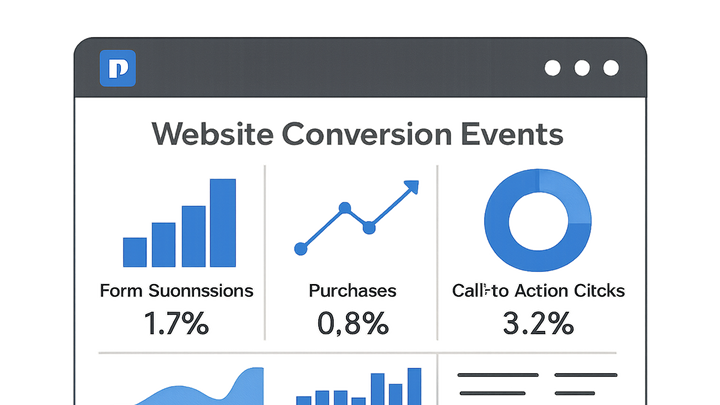Published on 2025-06-29T21:36:37Z
What is Conversion Tracking? Examples for Website CRO/UX/SEO
Conversion Tracking is the process of measuring and analyzing user actions on a website that align with business objectives, such as form submissions, purchases, or newsletter sign-ups. By instrumenting events and goals through analytics platforms and tools like Google Analytics and solutions like Prevue.me, teams can collect quantitative data to understand user behavior. This data-driven approach is critical for optimizing conversion rates, enhancing user experience, and maximizing the return on marketing and design efforts. Conversion tracking reveals where visitors drop off or encounter friction, guiding targeted improvements to CTAs, forms, and page designs. Ultimately, conversion tracking empowers marketers, UX designers, and SEO specialists to make informed decisions, validate hypotheses, and demonstrate the value of optimization initiatives.
Conversion tracking
Conversion tracking measures and analyzes user actions on your site, enabling data-driven CRO, UX improvements, and ROI optimization.
Understanding Conversion Tracking
An overview of what constitutes a conversion, the different kinds of conversion events, and the core metrics you need to monitor.
-
Definition of a conversion
A conversion is any predefined action a user takes on your website that aligns with business goals, such as form submissions, purchases, or downloads.
-
Types of conversions
Conversions are typically categorized based on their impact, guiding prioritization in optimization efforts.
- Macro conversions:
High-value actions directly tied to revenue or primary goals, e.g., completed purchases or lead form submissions.
- Micro conversions:
Smaller engagements that indicate user interest, e.g., newsletter sign-ups or PDF downloads.
- Macro conversions:
-
Key metrics in conversion tracking
Tracking multiple metrics gives a holistic view of performance across stages of the funnel.
- Conversion rate:
Percentage of visits resulting in a conversion, calculated as (conversions ÷ total visits) × 100.
- Total conversions:
Absolute number of goal completions within a given period.
- Average value per conversion:
Monetary value per conversion, useful for revenue forecasting and budget allocation.
- Conversion rate:
Importance of Conversion Tracking for CRO/UX/SEO
How robust conversion tracking underpins optimization strategies across marketing, design, and search.
-
Data-driven decision making
Conversion tracking provides empirical evidence to guide optimizations, replacing guesswork with measurable insights.
-
Measuring roi
By attributing conversions to specific channels or campaigns, you can calculate return on investment and allocate budgets effectively.
-
Identifying ux friction points
Analyzing drop-offs at conversion stages uncovers user experience issues such as confusing CTAs or broken form fields.
Implementing Conversion Tracking
Step-by-step methods to set up and validate your conversion events using popular analytics tools and prevue.me.
-
Selecting goals and conversion events
Define clear, measurable goals aligning with overall business objectives, assigning meaningful event names and values.
-
Setting up in google analytics
Implement tracking by creating events and goals in GA4, using gtag.js or Google Tag Manager to fire conversion events upon user actions.
- Using gtag.js:
Add event code snippets to page templates or inline scripts to send conversion events directly to GA4.
- Using google tag manager:
Configure triggers and tags without code changes, leveraging built-in templates for common events.
- Using gtag.js:
-
Leveraging prevue.me for actionable critiques
Use prevue.me to audit your site’s CRO, UX, SEO, and accessibility, receiving prioritized recommendations to optimize conversion paths.
- Critique lead generation forms:
Identify fields that cause friction and suggest streamlining form UX to boost submissions.
- Optimize ctas and navigation:
Analyze CTA placement and copy to enhance clarity and visibility across devices.
- Seo impact on conversion:
Receive SEO-related fixes to improve page speed and content relevance, reducing bounce rates.
- Critique lead generation forms:
Best Practices and Common Pitfalls
Guidelines to maintain accurate tracking and avoid mistakes that can skew your data.
-
Regular auditing and validation
Conduct frequent audits of conversion setup to ensure events fire correctly after site updates or redesigns.
-
Ensuring data accuracy
Filter out internal traffic, resolve duplicate events, and verify that tags aren’t blocked by ad blockers or consent tools.
-
Avoiding common tracking pitfalls
Beware of tracking too many events, inconsistent naming conventions, and ignoring attribution windows, which can skew insights.
